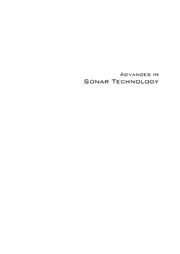
Advances in Sonar Technology PDF
Preview Advances in Sonar Technology
Advances in Sonar Technology Advances in Sonar Technology Edited by Sergio Rui Silva I-Tech IV Published by In-Teh In-Teh is Croatian branch of I-Tech Education and Publishing KG, Vienna, Austria. Abstracting and non-profit use of the material is permitted with credit to the source. Statements and opinions expressed in the chapters are these of the individual contributors and not necessarily those of the editors or publisher. No responsibility is accepted for the accuracy of information contained in the published articles. Publisher assumes no responsibility liability for any damage or injury to persons or property arising out of the use of any materials, instructions, methods or ideas contained inside. After this work has been published by the In-Teh, authors have the right to republish it, in whole or part, in any publication of which they are an author or editor, and the make other personal use of the work. © 2009 In-teh www.in-teh.org Additional copies can be obtained from: [email protected] First published February 2009 Printed in Croatia p. cm. ISBN 978-3-902613-48-6 1. Advances in Sonar Technology, Sergio Rui Silva Preface The demand to explore the largest and also one of the richest part of our planet, the advances in signal processing promoted by an exponential growth in computation power and a thorough study of sound propagation in the underwater realm, lead to remarkable advances in sonar technology in the last years. Since the use of imaging system that rely on electromagnetic waves (optical, laser or radar) is restricted to only very shallow water environments, and given that the good propagation of sound waves in water is known from at least the writings of Leonardo da Vinci, the sonar (sound navigation and raging) systems are the most widespread solution for underwater remote sensing. Sonar systems can be divided into two major types: passive sonar systems that enable detection of a sound emitting target and active sonar systems that use the properties of a signal reflected on the targets for its detection and image formation. As system complexity increases, the study of the way sound is used to obtain reflectivity and bathymetry data from targets and submersed areas becomes fundamental in the performance prediction and development of innovative sonar systems. Because of the many similarities between sonar and radar, algorithms created for the latter found application in sonar systems which made use of the advances in signal processing to overcome the barriers of the problematic underwater propagation medium and to challenge the resolution limits. In particular, synthetic aperture methods, applied with so much success in radar imagery, were adapted to sonar systems. This in turn enabled a considerable increase in sonar image quality and system robustness. Target detection developments lead to the use of multiple transducer sensors and sophisticated beam forming techniques with also excellent results. High quality sonar imagery with reduced noise and enhanced resolution enables more complex applications. Leaving the traditional real of military applications, sonar civil applications arise for the study of biology ecology and related fields. Moreover integration and data fusion of different sensors is becoming more and more common, being it navigation data integration and enhancement for synthetic aperture, sonar systems with different propagation characteristics or optical image integration for the improvement of object detection. But, not unlike natural evolution, a technology that matured in the underwater environments is now being used to solve problems for robots that use the echoes from air- acoustic signals to derive their sonar signals. The work on hand is a sum of knowledge of several authors that contributed in various different aspects of sonar technology. This book intends therefore to give a broad overview of the advances in sonar technology of the last years that resulted from the research effort of the authors in both sonar systems and its applications. It is destined to scientist and VI engineers from a variety of backgrounds and, hopefully, even those that never had contact with sonar technology before will find an easy entrance in the topics and principles exposed here. The editor would like to thank all authors for their contribution and all those people who directly or indirectly helped make this work possible, especially Vedran Kordic who was responsible for the coordination of this project. Editor Sergio Rui Silva University of Porto Contents Preface V Side-looking Sonar 1. Simulation and 3D Reconstruction of Side-looking Sonar Images 001 E. Coiras and J. Groen Synthetic Aperture Sonar 2. Synthetic Aperture Techniques for Sonar Systems 015 Sérgio Rui Silva, Sérgio Cunha, Aníbal Matos and Nuno Cruz 3. Motion Compensation in High Resolution 043 Synthetic Aperture Sonar (SAS) Images R. Heremans, Y. Dupont and M. Acheroy Sonar Image Enhancement 4. Ensemble Averaging and Resolution Enhancement of Digital Radar 075 and Sonar Signals Leiv Øyehaug and Roar Skartlien Sonar Detection and Analysis 5. Independent Component Analysis for Passive Sonar Signal Processing 091 Natanael Nunes de Moura, Eduardo Simas Filho and José Manoel de Seixas 6. From Statistical Detection to Decision Fusion: Detection 111 of Underwater Mines in High Resolution SAS Images Frédéric Maussang, Jocelyn Chanussot, Michèle Rombaut and Maud Amate Sonar Sensor Integration 7. Multi-Sonar Integration and the Advent of Senor Intelligence 151 Edward Thurman, James Riordan and Daniel Toal VIII 8. On the Benefits of Using Both Dual Frequency Side Scan Sonar 165 and Optical Signatures for the Discrimination of Coral Reef Benthic Communities Tim J Malthus and Evanthia Karpouzli Air-acoustics Sonar Systems 9. Outdoor Sonar Sensing 191 Fernando J. Álvarez Franco and Jesús Ureña Ureña 10. Mobile Robot Localization using Particle Filters and Sonar Sensors 213 Antoni Burguera, Yolanda González and Gabriel Oliver Side-looking Sonar
